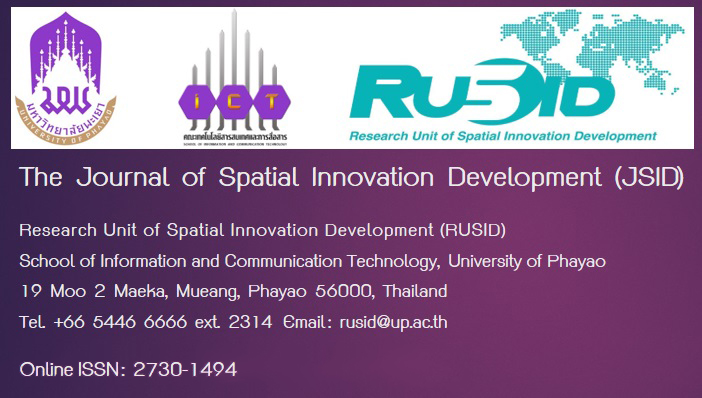Development of Pediatric Physical Therapy Instructional Media of Primitive Reflexes and Automatic Reaction for Physical Therapy Students
Keywords:
Instructional Media, Primitive Reflexes and Automatic Reaction, Physical Therapy StudentsAbstract
This research involves the development of pediatric physical therapy instructional media of primitive reflexes and automatic reaction for physical therapy students. The purposes of this research were: 1) to evaluate the efficiency of experts in developing pediatric physical therapy instructional media 2) to evaluate students' satisfaction towards the development of pediatric physical therapy instructional media and 3) to compare the satisfaction levels of the 3rd and 4thyear students regarding the developed of pediatric physical therapy instructional media based on years of education. This research targeted 89 undergraduate students in the Physical Therapy Program, School of Allied Health Sciences, University of Phayao in the academic year 2023. The research instruments were divided into three parts: 1) pediatric physical therapy instructional media 2) efficiency assessment form for experts and 3) satisfaction assessment form for students, using a 5-level rating scale. The statistics used to analyze the data were: percentage, mean, standard deviation, and an independent t-test. The results found that there were 89 respondents, with an average age of 21.58±0.82 years. 44 (49.44%) third-year students and 45 (50.56%) fourth-year students. The results of data analysis revealed that: 1) The efficiency of eight experts towards pediatric physical therapy instructional media was at the excellent level (4.74±0.30). 2) The students' satisfaction towards the development of pediatric physical therapy instructional media was at the highest level. (4.74±0.32) and 3) No statistical differences were found between years in students' satisfaction towards the development of pediatric physical therapy instructional media.
References
กิดานันท์ มลิทอง. (2548). เทคโนโลยีและการสื่อสารเพื่อการสื่อสาร. กรุงเทพฯ: อรุณการพิมพ์.
กนกกาญจน์ ทองศฤงคลี, ขวัญหญิง ศรีประเสริฐภาพ และสุวิมล กฤชคฤหาสน์. (2556). การพัฒนาชุดเครื่อง มือการประเมินสื่อการเรียนการสอนสำหรับการวิจัยทางด้านเทคโนโลยีการศึกษา. วารสารวิจัยราชภัฎพระนคร, 8(2), 1-10.
กระทรวงสาธารณสุข. (2562). คู่มือการประเมินและส่งเสริมพัฒนาการเด็กกลุ่มเสี่ยง. กรุงเทพฯ: สำนักงานกิจการโรงพิมพ์องค์การสงเคราะห์ทหารผ่านศึก.
ใจทิพย์ ณ สงขลา. (2561). การออกแบบการเรียนแนวดิจิทัล (Digital Learning Design). กรุงเทพฯ: ภาควิชาเทคโนโลยีและสื่อสารการศึกษาคณะครุศาสตร์ จุฬาลงกรณ์มหาวิทยาลัย.
พิมพ์วรีย์ อาทรวรางกูร, จารุณี ทิพยมณฑล และ ชรินทร์ มั่งคั่ง. (2565). การจัดการเรียนการสอนภาษาดิจิทัลฐานภาระงานแบบไฮบริด เพื่อผู้เรียนยุคดิจิทัลในศตวรรษที่ 21. วารสารวิชาการและวิจัยสังคมศาสตร์, 17(2), 13-30.
ภรภัทร สําอางค์. (2564). การพัฒนาสื่อวีดิทัศน์เรื่องการใช้เครื่องวัดค่าการดูดกลืนแสงด้วยคิวอาร์โค้ดในรูปแบบออนไลน์สําหรับนักศึกษาสาขาวิชาเคมีคณะวิทยาศาสตร์และเทคโนโลยีมหาวิทยาลัยราชภัฏพิบูลสงคราม. วารสารครุพิบูล, 8(2), 148-156.
วราพร ดำจับ. (2562). สื่อสังคมออนไลน์กับการเรียนรู้ในศตวรรษที่ 21. วารสารศิลปศาสตร์ มหาวิทยาลัยแม่โจ้, 7(2), 143-159.
สำเนา หมื่นแจ่ม, (2556). การพัฒนาคุณภาพการจัดการเรียนรู้ที่เน้นผู้เรียนเป็นสำคัญโดยใช้สื่อเทคโนโลยี. วารสารวิจัยราชภัฎเชียงใหม่, 14(2), 86-96.
เรืองศักดิ์ ศรีรักษา, นิตยารัตน์ คงนาลึก, เศณวี ฤกษ์มงคล และ อนุวัฒน์ จันทสะ. (2565). การพัฒนาสื่อการเรียนรู้โดยใช้โปรแกรม Canva เพื่อส่งเสริมผลสัมฤทธิ์ทางการเรียนรู้ เรื่อง พลเมืองดิจิทัล รายวิชา วิทยาการคำนวณ. วารสารครุศาสตร์ มหาวิทยาลัยราชภัฏนครศรีธรรมราช, 1(1), 51-58. สืบค้นจาก https://so16.tci-thaijo.org/index.php/EJ-NSTRU/article/view/476.
Ahmed, W., & Zaneldin, E. (2020). Blending QR code with video learning in the pedagogical process for the college foundation level. Interactive Technology and Smart Education, 17(1), 67-85. Form https://doi.org/10.1108/ITSE-08-2019-0043.
Blasco P. A. (1994). Primitive reflexes. Their contribution to the early detection of cerebral palsy. Clinical pediatrics, 33(7), 388–397. Form https://doi.org/10.1177/000992289403300703.
Fiorentino, M. R. (1974). Reflex testing methods for evaluating CNS development. American Journal of Physical Medicine & Rehabilitation, 53(6), 300.
Melillo, R., Leisman, G., Machado, C., Machado-Ferrer, Y., Chinchilla-Acosta, M., Kamgang, S., Melillo, T., & Carmeli, E. (2022). Retained Primitive Reflexes and Potential for Intervention in Autistic Spectrum Disorders. Frontiers in neurology, 13, 922322. Form https://doi.org/10.3389/fneur.2022.922322.
Parasin N. (2023). Primitive reflexes and automatic reaction (Teaching Publications). Phayao: University of Phayao.
Pundita Intharaksa. (2019). การจัดการเรียนรู้ด้วยสื่อสังคมออนไลน์ (LEARNING MANAGEMENT WITH SOCIAL MEDIA). Journal of Education and Innovation, 21(4), 357–365. From https://so06.tci-thaijo.org/index.php/edujournal_nu/article/view/116500.
Taber, K.S. (2018). The Use of Cronbach’s Alpha When Developing and Reporting Research Instruments in Science Education. Res Sci Educ, 48, 1273–1296. Form https://doi.org/ 10. 1007/s11165-016-9602-2.
The APTA Academy of Pediatric Physical Therapy (2019), The ABCs of Pediatric Physical Therapy. Retrieved April, 25, 2024, from https://pediatricapta.org/includes/fact-sheets/pdfs/FactSheet_ABCsofPediatricPT_2019.pdf?v=2.
Yamane, Taro. (1967). Statistics: An Introductory Analysis (2nd Edition). New York: Harper and Row.
Zafeiriou D. I. (2004). Primitive reflexes and postural reactions in the neurodevelopmental examination. Pediatric neurology, 31(1), 1–8. Form https://doi.org/10.1016/j.pediatrneurol. 2004.01.012.





